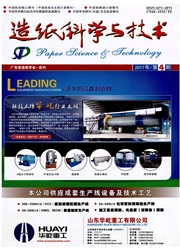

 中文摘要:
中文摘要:
主要探讨绵竹和桉木硫酸盐木素在低温/短时间的水热解条件下生成高附加值产物。绵竹总油得率随反应温度(130℃,180℃,230℃)的升高而减少,随反应时间(15 min,60 min)的增加而增加,得率范围为5.4wt%~10.6wt%;相同反应条件下,桉木总油得率随反应温度和反应时间的增加而减少,且得率为7wt%~10wt%。通过气质联用(GC-MS)检测油的主要组成成分愈创木基(2-甲氧基苯酚)在不同实验条件下在油中的比率分别为19%-78%、12%-55%。采用凝胶色谱(GPC)和红外光谱(FTIR)检测残余硫酸盐木素,用于说明硫酸盐木素的转化机制。在硫酸盐木素水热解过程中,伴随着β-O-4结构的断裂,羟基、羰基和芳香环结构的减少,进而引起硫酸盐木素酚羟基数量的增加。
 英文摘要:
英文摘要:
The aim of this study is to explore hydrothermal conversion of bamboo and eucalyptus kraft lignin at low temperature/short time for value - added products. With ranging between 5.4wt%- 10.6 wt%, total oil yield of bamboo decreased with the increase of temperature ( 130℃ , 180℃ , and 230℃ ) , the longer reaction time ( 15 min,60 rain) led to increase of total oil yield,but the total oil yield of eucalyptus decreased with both increase of temperature and the longer reaction time, the total oil yield was found to range between 7wt% ~ 10wt% o Main compound of oils characterized by GC -MS was guaiacol (2 -methoxy phenol) in the range of 19% -78% and 12% - 55% of oil depending on different reaction conditions. Residual kraft lignins were characterized by GPC and FFIR with respect to the conversion mechanism of kraft lignin by this process. The conversion of kraft lignin under hydrothermal conditions had something to do with the degradation of β - O -4 linkages, hydroxyl groups, carbonyl groups, aromatic rings, resulting in the increased amount of phenolic OH groups in kraft lignin.
 同期刊论文项目
同期刊论文项目
 同项目期刊论文
同项目期刊论文
 Removal of lignin from cell microregions in sweet bamboo (Dendrocalamus brandisii) catalyzed by Co(s
Removal of lignin from cell microregions in sweet bamboo (Dendrocalamus brandisii) catalyzed by Co(s TCF Bleaching of Eucalyptus Urophylla×Eucalyptus Grandis LH107 oxygen-delignified kraft pulp – Parti
TCF Bleaching of Eucalyptus Urophylla×Eucalyptus Grandis LH107 oxygen-delignified kraft pulp – Parti Salen copper (II) complex encapsulated in Y zeolite: An effective heterogeneous catalyst for TCF pul
Salen copper (II) complex encapsulated in Y zeolite: An effective heterogeneous catalyst for TCF pul Catalytic oxidation and conversion of kraft lignin into phenolic products using zeolite-encapsulated
Catalytic oxidation and conversion of kraft lignin into phenolic products using zeolite-encapsulated Application of zeolite-encapsulated Cu(II) [H4]salen derived from [H2]salen in oxidative delignifica
Application of zeolite-encapsulated Cu(II) [H4]salen derived from [H2]salen in oxidative delignifica Polychlorinated dibenzo-p-dioxins and polychlorinated dibenzofurans concentrations in Xingyun Lake s
Polychlorinated dibenzo-p-dioxins and polychlorinated dibenzofurans concentrations in Xingyun Lake s Oxidation of a lignin model compound of benzyl-ether type linkage in water with H2O2 under an oxygen
Oxidation of a lignin model compound of benzyl-ether type linkage in water with H2O2 under an oxygen 期刊信息
期刊信息
